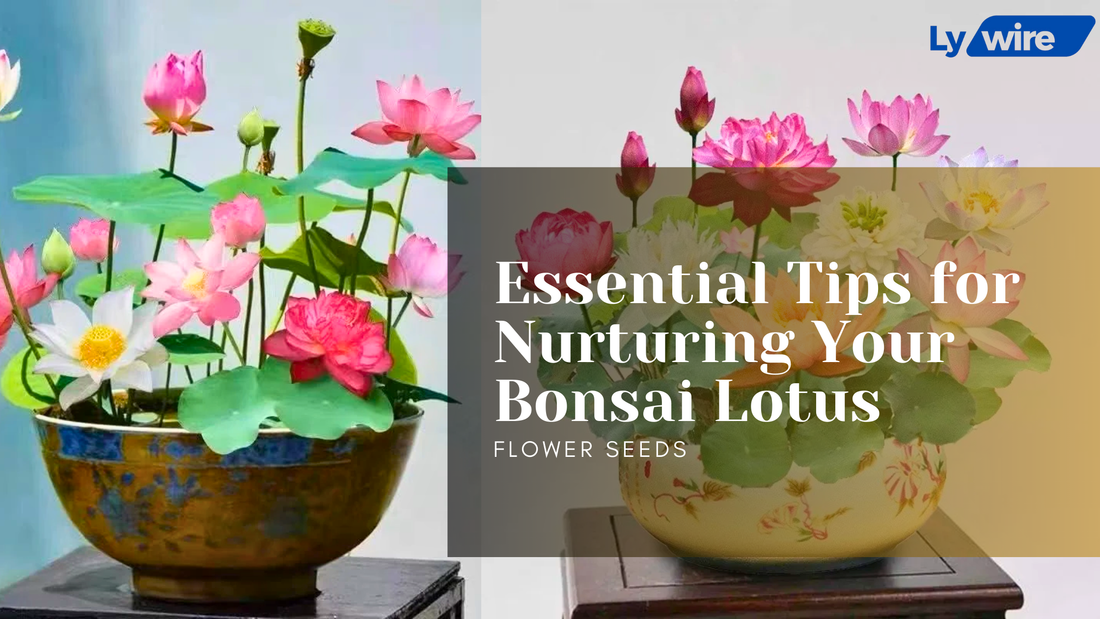
Growing bonsai lotus flowers from seeds can be a rewarding and fulfilling experience. These stunning aquatic plants not only beautify your garden or home but also symbolize purity and enlightenment in various cultures. This comprehensive guide will provide you with essential tips to successfully nurture your bonsai lotus flower seeds, ensuring that you enjoy their breathtaking blooms for years to come.
Understanding the Bonsai Lotus Flower
What is a Bonsai Lotus?
The bonsai lotus (Nelumbo nucifera) is a sacred flower known for its striking beauty and cultural significance. It thrives in water and can be grown in pots or directly in ponds. The lotus is unique because it can grow in muddy waters, yet it produces pristine flowers that rise above the surface, symbolizing purity and resilience.
Why Grow Bonsai Lotus?
- Aesthetic Appeal: The lotus flower's vibrant colors and unique shape add beauty to any landscape.
- Cultural Significance: In many cultures, the lotus represents spiritual awakening and purity.
- Therapeutic Benefits: Gardening has been shown to reduce stress and promote mental well-being.

Preparing to Grow Your Bonsai Lotus
Before you start nurturing your bonsai lotus seeds, it’s essential to prepare adequately. Here are the steps to ensure a successful growing process:
1. Gather Your Supplies
To grow bonsai lotus from seeds, you will need:
- Lotus Seeds: Purchase high-quality seeds from a reputable source.
- Containers: Choose a large, deep pot (at least 12 inches deep) without drainage holes.
- Soil: Use a mixture of clay soil and sand; avoid regular potting soil as it may float.
- Water: Ensure access to clean, warm water for germination.
2. Preparing the Seeds
Lotus seeds have a hard outer shell that must be prepared for germination:
- Scarification: Use a knife or file to gently nick or sand the seed's outer layer until you reach the cream-colored inner part. This step allows water to penetrate the seed more easily.
- Soaking: Place the prepared seeds in warm water (70-85°F or 21-29°C) for 24 hours to initiate swelling.
Germinating Your Bonsai Lotus Seeds
Once your seeds are prepared, it's time to germinate them:
1. Germination Process
- Container Setup: Place the soaked seeds in a clear container filled with warm water. Keep this container in a sunny location.
- Water Maintenance: Change the water daily to prevent cloudiness and bacterial growth. You should see sprouting within a week.
- Transplanting Sprouts: When the stems reach about 4 inches long, carefully transfer them into a shallow bowl with 3 inches of your soil mix and more warm water.

Planting Your Bonsai Lotus
After successfully germinating your seeds and nurturing the sprouts, it's time to plant them in their final home:
1. Choosing the Right Pot
Select a pot that is at least 12 inches deep and 24 inches wide. Ensure it has no drainage holes as lotus plants thrive in standing water.
2. Planting Instructions
- Soil Layering: Add 3-5 inches of your clay-sand mixture at the bottom of the pot.
- Planting Technique: Place the sprouted tubers into the soil and cover them lightly with more soil. Fill the pot with warm water until it just covers the leaves.
Caring for Your Bonsai Lotus
Proper care is crucial for your bonsai lotus to thrive:
1. Watering Needs
Keep the water level consistent, ensuring it does not drop significantly due to evaporation. Monitor regularly, especially during hot weather.
2. Sunlight Requirements
Lotus flowers require full sun exposure for at least 6 hours daily. Ensure they are placed in a location where they receive adequate sunlight.
Fertilizing Your Bonsai Lotus
Fertilization plays an important role in promoting healthy growth:
1. Choosing Fertilizer
Use an aquatic fertilizer with an N-P-K ratio of 10-14-8. This type of fertilizer is specifically formulated for aquatic plants.
2. Fertilization Schedule
Start fertilizing once your lotus has established aerial leaves (leaves above water). Apply every 2-3 weeks during the growing season for optimal results.
Overwintering Your Bonsai Lotus
As winter approaches, it's essential to prepare your bonsai lotus for dormancy:
1. Indoor Transition
If you live in colder climates, consider bringing your pot indoors during freezing temperatures. This helps prevent damage to the tubers.
2. Water Management
Ensure that the water does not freeze completely over winter, as this can harm your plant's roots.

Troubleshooting Common Issues
Even with proper care, you may encounter challenges while growing bonsai lotus flowers:
1. Yellowing Leaves
If you notice yellowing leaves after rapid growth, don’t panic; this is often temporary as your plant thickens its tubers before resuming growth.
2. Pests
Watch out for pests like aphids on new growth. You can rinse them off with water or remove them by hand if necessary.
Nurturing bonsai lotus flower seeds requires patience and attention but rewards you with stunning blooms that enhance your garden or indoor space.
By following these essential tips—from seed preparation and germination to planting and care—you can create a thriving aquatic oasis right at home. Enjoy watching your bonsai lotus flourish as it embodies beauty and serenity throughout its growth cycle!

